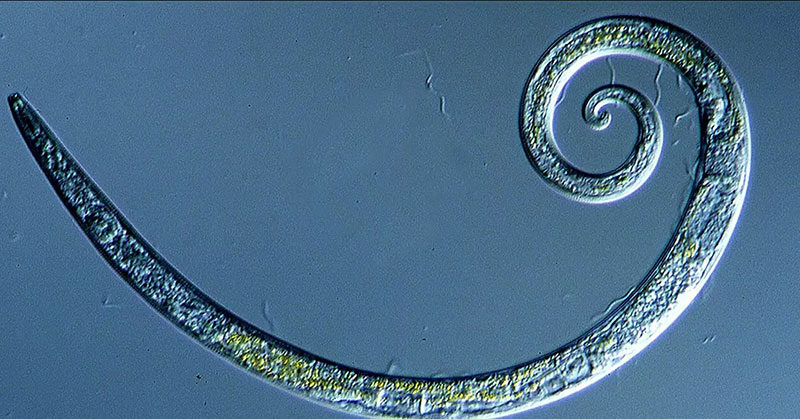As climate change continues to progress and our world gradually gets warmer, changes are occurring in ecosystems across the earth. Nowhere is this change more evident than in the earth’s poles. In 2018, researchers successfully revived two species of frozen worms from melting permafrost in Siberia. These worms are now awake, after being frozen for 42 thousand years.
The Frozen Worms
Siberia is one of the northernmost areas of Russia. Large areas of Siberia were formed by permafrost tens of thousands of years ago. Today, as our planet is warming up, that permafrost is beginning to melt.
This melting permafrost is releasing nematodes, which are microscopic worms that live in the soil. In 2018, scientists successfully revived two species of these once-frozen worms. These worms had been locked in frozen earth since the Pleistocene era.
The researchers isolated females from two different species- Panagrolaimus detritophagus and Plectus parvus. Once the worms defrosted, they began moving and eating. This is the first evidence of “natural cryopreservation” of multicellular organisms [1].
The scientists collected the samples from two different locations. One was from a fossil squirrel burrow in Yakutia, Russia, that is approximately 32 thousand years old. The other permafrost sample came from the Kolyma river in northeastern Siberia. Those deposits are around 42 thousand years old [1].
What is Permafrost?
Permafrost is when ice binds together soil, rock, sand, and organic matter. It occurs in the coldest regions of the world, anywhere where the ground is frozen year-round for at least two years. This happens mainly in the arctic regions of Greenland, Alaska, Russia, China, and Europe.
Permafrost can begin mere centimeters below the earth’s surface, and often contains the remains of dead plants and animals. It can also be as deep as 1500 meters, or 4900 feet [2].
Why is the Permafrost Thawing?
Forests and plants on the Earth’s surface help to keep the ground cooler. This allows the permafrost to remain intact. As the earth’s temperature has been rising, however, more frequent and hotter fires are destroying this protective layer.
Beneath that layer is a second peat layer. Peat also helps insulate the ground and prevents the permafrost from melting. This layer, however, stores large amounts of carbon. This means that when it burns because of a forest fire, it releases massive amounts of carbon and greenhouse gasses into the atmosphere.
Other issues affecting the permafrost layer include:
- Heavy summer rain. Heavy amounts of rain soak the ground, which causes it to warm up and accelerate the thawing process.
- Human activity. As humans build towns and cities above ground, it destabilizes the permafrost layer below. Things like underground pipes and tree cutting generate heat, which causes the permafrost to thaw.
- Melting sea ice. As sea ice in arctic regions is melting, it is exposing permafrost along the coast to warmer water, waves, and storms [2].
Why is Melting Permafrost Important?
Frozen worms aren’t the only thing that’s being released from permafrost.
Thawing permafrost poses a massive threat to our planet. This important layer beneath the earth’s surface stores more carbon than the atmosphere. When it thaws, this carbon may convert into carbon dioxide and methane gas. This, then, will enter into the atmosphere.
If the arctic warms by only a couple of degrees celcius, it will cause a massive permafrost thawing. This will release those greenhouse gasses and accelerate global warming even further.
A team of scientists from Stockholm University has found evidence of past permafrost thawing at the end of the last ice age.
“Our new study shows for the first time the full history of how warming at the end of the last ice age triggered permafrost thawing in Siberia. This also suggests the release of large quantities of greenhouse gases,” says Jannik Martens, PhD student at Stockholm University and lead author of the study. “It seems that Arctic warming by only a few degrees Celsius is sufficient to disturb large areas covered by permafrost and potentially affect the climate system”. [3]
Read: Ice Melt in Alaska Threatens to Unleash Unprecedented ‘Mega-Tsunami’, Scientists Warn
Frozen Worms Aside, What Else Will Be Released from Permafrost?
Greenhouse gasses won’t be the only thing that enters our atmosphere when the permafrost melts. Volatile organic compounds will also be released from the soil that could have a significant impact on climate change.
According to researchers at the University of Helsinki, these compounds include monoterpenes, sesquiterpenes, and diterpenes. These compounds can be highly reactive, and contribute to the formation of small particles that suspend in the air.
This could increase cloud formation, which may actually reflect solar radiation away from the earth. As of now, scientists do not know for certain if this will improve or worsen climate change.
“For now, it’s impossible to say with certainty whether the release of organic compounds accelerates or decelerates climate change. They introduce in any case additional uncertainties to climate change modelling.” says Associate Professor Federico Bianchi from the University of Helsinki’s Institute for Atmospheric and Earth System Research (INAR) [4].
Read: Dozens of Previously Unknown Viruses Discovered in 15,000-year-old Glaciers
An Uncertain Future
As climate change continues, it is difficult to predict everything that will take place as a result. For this reason, it is incredibly important that as a society we continue to work toward a future in which we reduce our impact on the environment.
Individuals, businesses, and governments need to commit to a carbon-neutral future. Frozen worms are only the beginning.
Keep Reading: Since 1950, It Has Been ‘Illegal To Die’ In The Arctic Town Of Longyearbyen
- https://link.springer.com/article/10.1134/S0012496618030079
- https://graphics.reuters.com/CLIMATE-CHANGE/PERMAFROST/oakveelglvr/
- https://www.technologynetworks.com/tn/news/permafrost-thaw-in-arctic-ocean-risks-large-scale-methane-release-342075
- https://www.sciencedaily.com/releases/2020/10/201014141028.htm

